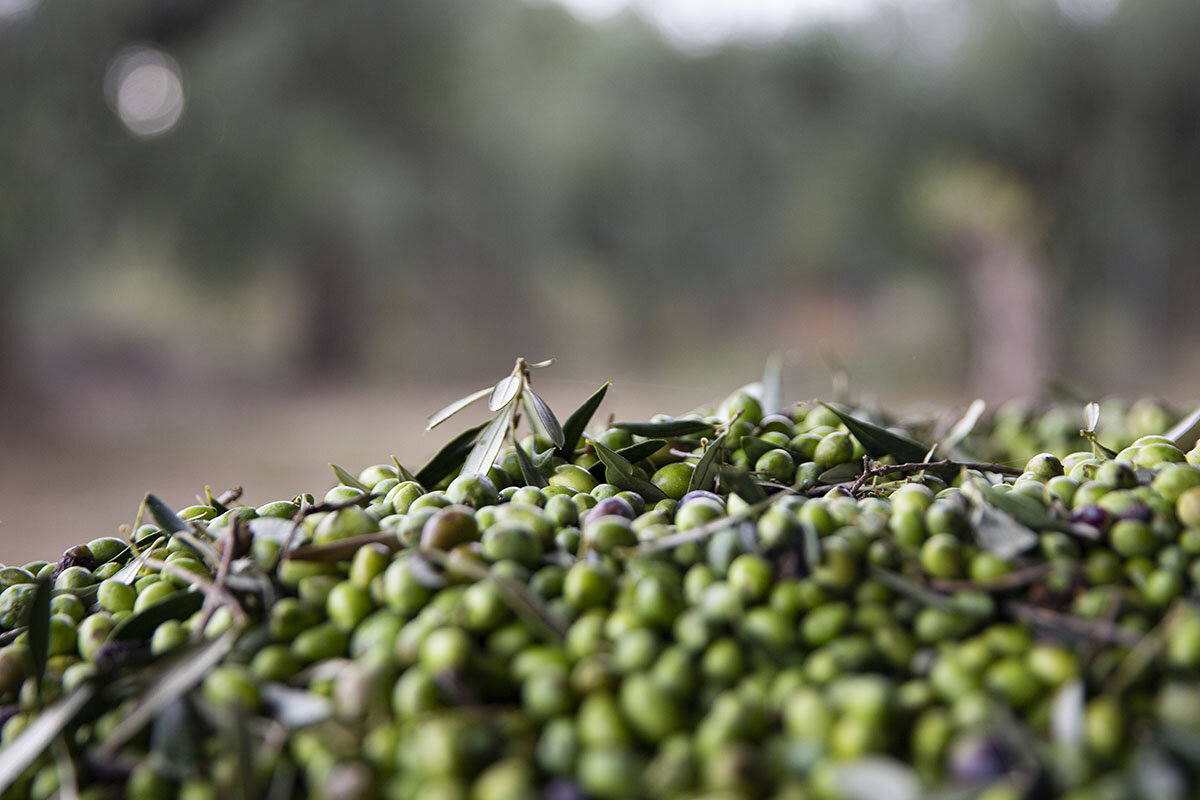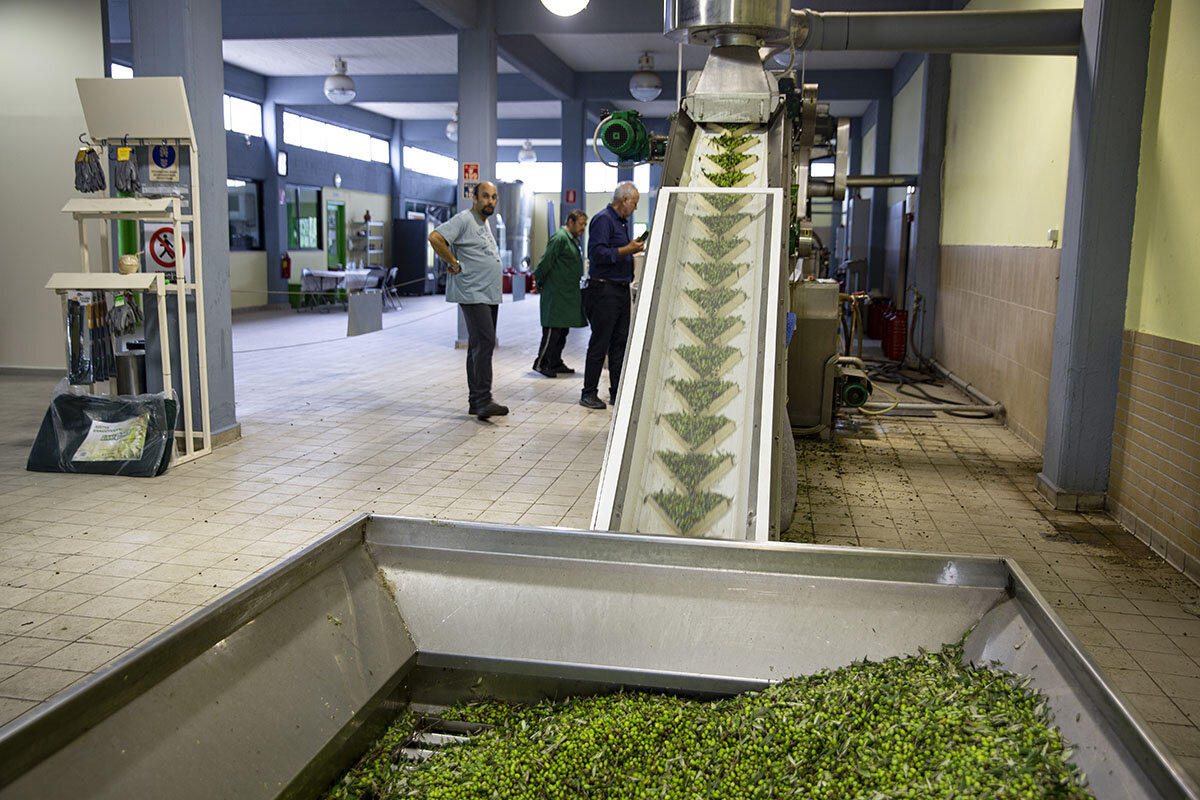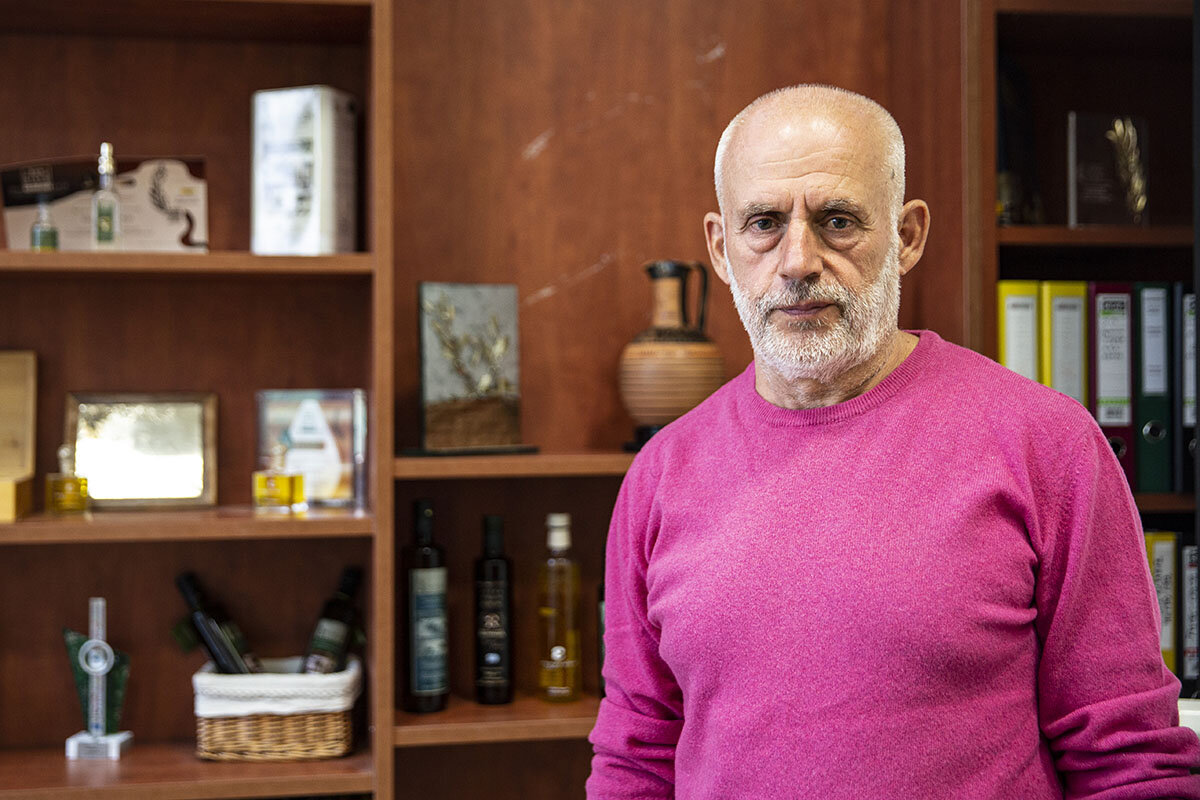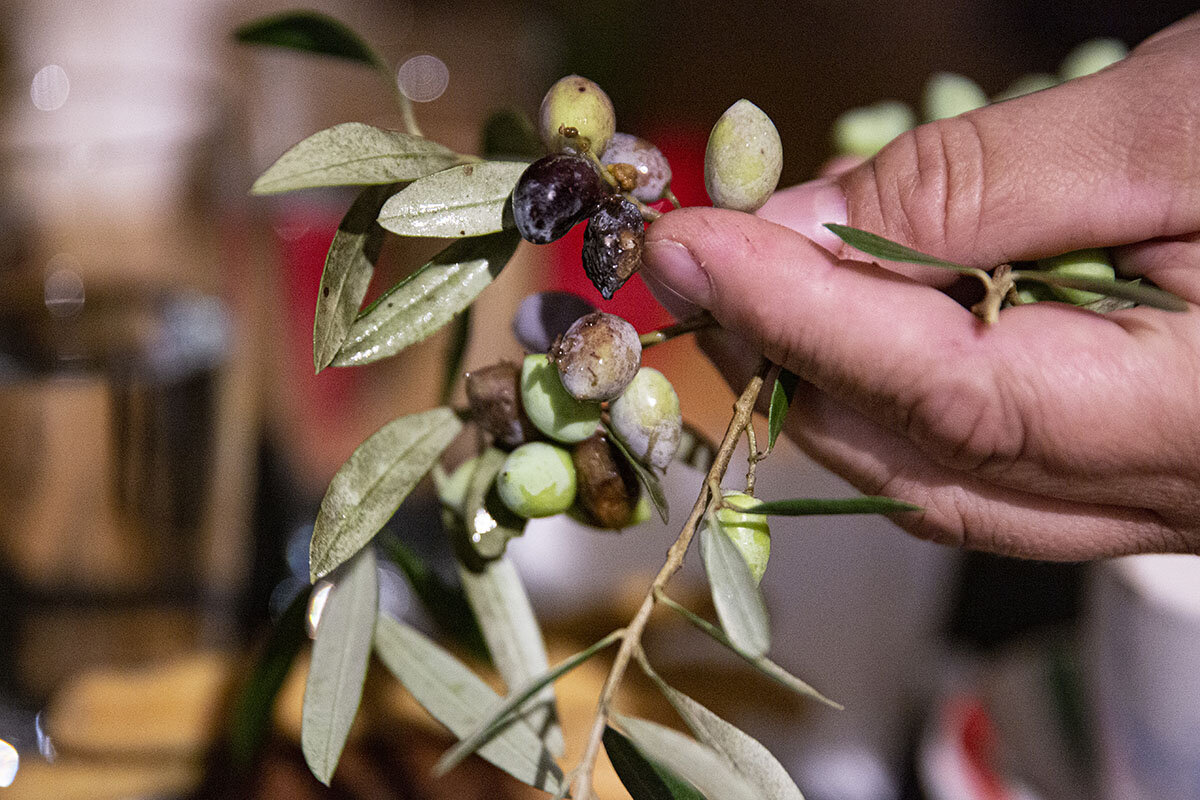In Greece, iconic olive crop becomes a climate change front line
Loading...
| Kalamata, Greece
One November day in Kalamata, Greece, as the community olive mill operates at full throttle, the rain outside turns to hail. A furious wind sways and snaps branches of the surrounding olive trees, some hundreds of years old, as a worker on a truck drops crate after crate of olives into an industrial crusher.
Climate change has been wreaking havoc on Kalamata’s olive crop this year. It endured winter conditions during the spring and experienced relatively low summer temperatures. That unusual weather, coupled with low rainfall, resulted in fewer and smaller olives. The region typically produces 45 thousand tons of olives per winter, but it expects less than 35 thousand tons this year.
Why We Wrote This
A story focused onGreece’s iconic olive trees are at risk of becoming a victim to the ravages of climate change. So farmers are finding new ways to care for and harvest the crop, and maintain its viability in a warmer world.
But the mill is also representative of how Greek olive farmers are adapting. It is designed to run as sustainably as possible. Waste compost from the mill enriches the soil of the surrounding groves. It is the first mill in the region to rely on solar panel energy, and it recently secured a deal to sell electricity to the government.
“We want to adjust as soon as possible to the environment and be pioneers,” says Michael Antonopoulos, president of the Agricultural Cooperative of Kalamata. “Our place has to be fully ecological. We don’t care about higher productivity. We care about sustainability.”
Editor's note: The story has been updated to correct the amount of olives produced in the Kalamata region.
The olive tree, according to Greek mythology, was created by Athena, the goddess of wisdom, as a gift to the people of her namesake city, Athens. Olives and olive oil have become synonymous with Greece, and are credited, in part, with fueling the rise of Greek civilization.
But despite a history spanning thousands of years, these culinary pillars of Greek identity are under threat. Small farmers expect this year’s harvest season, which got underway in November, to be one of the worst years on record, thanks to climate change and the irregular seasonal shifts it has wrought upon the flowering process and fruit development.
“We are collecting olives much earlier than ever before. Our producers do not recall any year like this,” says Michael Antonopoulos, president of the Agricultural Cooperative of Kalamata. “I think we will see less and less olive trees not only in our region, but all the Mediterranean, because the Africa heat line is moving forward to Europe.”
Why We Wrote This
A story focused onGreece’s iconic olive trees are at risk of becoming a victim to the ravages of climate change. So farmers are finding new ways to care for and harvest the crop, and maintain its viability in a warmer world.
He is not alone in expecting southern Europe to look like northern Africa in the span of 50 to 100 years. But Mr. Antonopoulos, a geologist and geotechnical environmentalist by training, is optimistic. He points to a series of steps that the community is taking to adapt to unseasonal temperature variations. “You can’t change the climate, but you can adjust,” he says.
And he notes that traditional olive groves have an important role to play in combating climate change. They are carbon sinks and could easily be integrated into carbon-offsetting projects, increasingly popular but also controversial methods used to reduce the carbon footprint of a company or country. Kalamata is among six Greek cities participating in the European Union mission for 100 climate-neutral and smart cities by 2030.
“We want to adjust as soon as possible to the environment and be pioneers,” he says. “Our place has to be fully ecological. We don’t care about higher productivity. We care about sustainability. We know people in the future will appreciate that more than anything.”
“We harvest in our T-shirts”
One November day in Kalamata, as the mill that serves a community of roughly 300 olive oil producers operates at full throttle, the rain outside turns to hail. A furious wind sways and snaps branches of the surrounding olive trees, some hundreds of years old, as a worker on a truck drops crate after crate of olives into an industrial crusher.
It’s been that kind of year for Kalamata’s olive crop. In 2023, it endured winter conditions during the spring and, unlike much of Greece, experienced relatively low summer temperatures. That unusual weather, coupled with low rainfall, resulted in fewer and smaller olives. The region typically produces 45 thousand tons of olives per winter, but it expects less than 35 thousand tons this year.
“If you don’t have certain weather conditions at a certain time,” explains Mr. Antonopoulos, “you can’t have olive oil.”
But the mill is also representative of how Greek olive farmers are adapting to the new environment. It is designed to run as sustainably as possible. Waste compost from the mill enriches the soil of the surrounding groves. It is the first mill in the region to rely on solar panel energy, and it recently secured a deal to sell electricity to the Greek government. Further, its farmers have adjusted their pruning tactics to optimize water use. And geothermal energy heats the olive oil extraction plants.
Long-term adaptive planning is also starting to bear fruit now. In 2012, the European Union launched the Olive Clima project in the region, testing climate change mitigation and adaptation techniques. It tweaked olive cultivation practices with an eye to reducing greenhouse gas emissions and increasing carbon dioxide capture.
“It’s all about feeding the soil,” says George Kokkinos, head of the Nileas olive oil producers cooperative in the broader Messenia region, which encompasses Kalamata. “Soil health is top priority.”
The measures promoted by the EU include the recycling of pruned olive tree material and mulch. Farmers adjusted pruning techniques to maximize contact with air and sun, used trimmed material for compost and improving soil health, and intermixed planting olive trees with legumes.
“The philosophy was to look at how olive tree cultivation adapts to climate change,” adds Mr. Kokkinos. “It was the first time that we heard of the expression ‘climate change.’ We had not yet seen any consequences related to climate change. The consequences only start to be seen and felt here in 2016.”
One of the most visible of these consequences, he says, are warmer, humid winters. This led to the spread of fungal diseases. Another change is the longer spring and the delayed onset of summer. June, he notes, became a moody month, with warm and cold spells. Summer now starts in July and lasts longer. All that confuses the olive tree, which decides in February whether to flower and delivers olives in April.
“We had 30 degrees Celsius here [86 degrees Fahrenheit] on Nov. 9,” he says, shaking his head. “That would have been unbelievable back in the 1990s. The normal, maximum temperature for this place this time of year would have been 16-18 C [60-66 F]. Typically, we would start the harvest wearing heavy clothes. Now we harvest in our T-shirts.”
The mitigation measures are working, he says, even though recent summer heat waves dried up the soil. He sees evidence of that in a 30% loss of productivity this year on his grove, compared with much higher losses among those who took no measures. The techniques they tested in the project now form part of the EU sustainable agricultural policy. But he worries that the Greek government is not prioritizing action and the spread of know-how to other farmers.
“The farmer stands in the middle and does not connect the dots,” he says. “The average farmer in Greece is 60 years old. It’s a hard time. That’s true. But there are opportunities. The key is to adjust.”
Giorgos Tzortzinis – a young olive grower and oil taster – used to be a climate change skeptic. Not anymore. “Before we would just hear about it,” he says. “Now we see it with our own eyes.” Productivity at his family grove of 2,000 trees has dropped by 60% year on year.
That loss is offset by unusually high olive oil prices as climate change hits Spain, the world’s main producer, where drought and extreme heat waves have devastated production. Last year, he says, his olives were fetching €4.50 per kilo ($2.24 per pound). Now it is almost double – about €8.
“Nature always finds a way”
Temperatures finally dropped to winter levels on the first day of Maria Mylona’s harvest in Messenia. The joy of picking olives was matched by the relief of finally being able to turn on the fireplace and roll out the winter carpets at her hillside home flanked by olive trees. The November day coincided with rain – a welcome development in a land that is drying up.
“The trees don’t have many olives, and the olives are not good due to the drought,” she complains, pouring out tea and sharing some homegrown figs with her guests. “We expect 50% losses. Our trees have just a few olives. They should be fat and round and green. But they are black and small.”
She and her husband have been battling the last six years against fungi, which grows in humid conditions. They consider themselves lucky because only 10% of their trees are affected. The fungi cannot be eradicated, only contained. They are also trying to use more gentle approaches to olive pickings. Long are the days when they would bang the trees with sticks to unload the olives. Now they shake them gently with mechanical tools.
The biggest blessing, she says, is to still have the possibility to raise her children in the shadow and scent of the olive tree. “I want them to have and treasure this memory,” she says. “My parents did that for me. The trees and nature will take their time, but in the end, they will adjust. Nature always finds a way to complete its circle and survive.”
Jenny Tsiropoulou supported reporting for this story.
Editor's note: The story has been updated to correct the amount of olives produced in the Kalamata region.












